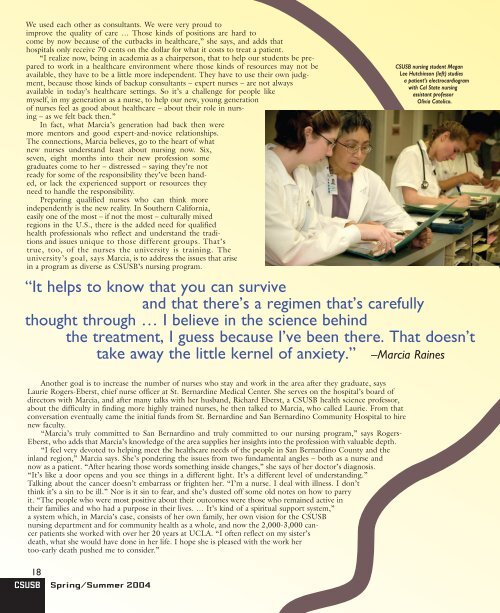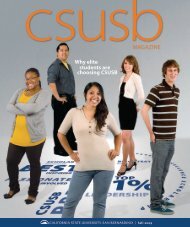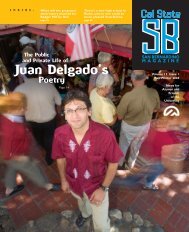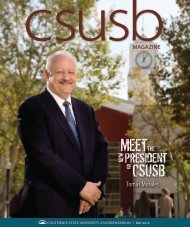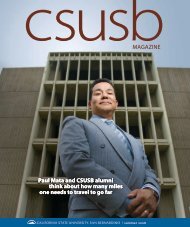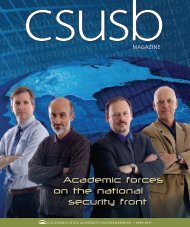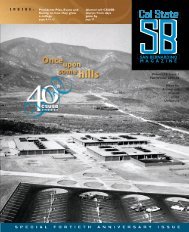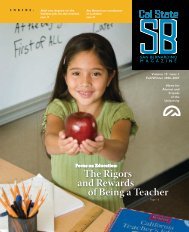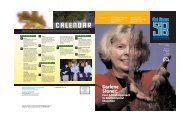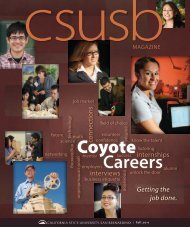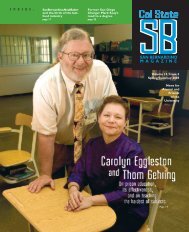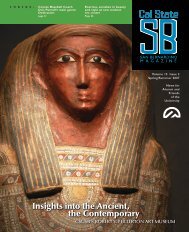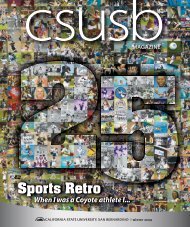The Road is Never Straight - CSUSB Magazine - California State ...
The Road is Never Straight - CSUSB Magazine - California State ...
The Road is Never Straight - CSUSB Magazine - California State ...
Create successful ePaper yourself
Turn your PDF publications into a flip-book with our unique Google optimized e-Paper software.
We used each other as consultants. We were very proud to<br />
improve the quality of care … Those kinds of positions are hard to<br />
come by now because of the cutbacks in healthcare,” she says, and adds that<br />
hospitals only receive 70 cents on the dollar for what it costs to treat a patient.<br />
“I realize now, being in academia as a chairperson, that to help our students be prepared<br />
to work in a healthcare environment where those kinds of resources may not be<br />
available, they have to be a little more independent. <strong>The</strong>y have to use their own judgment,<br />
because those kinds of backup consultants – expert nurses – are not always<br />
available in today’s healthcare settings. So it’s a challenge for people like<br />
myself, in my generation as a nurse, to help our new, young generation<br />
of nurses feel as good about healthcare – about their role in nursing<br />
– as we felt back then.”<br />
In fact, what Marcia’s generation had back then were<br />
more mentors and good expert-and-novice relationships.<br />
<strong>The</strong> connections, Marcia believes, go to the heart of what<br />
new nurses understand least about nursing now. Six,<br />
seven, eight months into their new profession some<br />
graduates come to her – d<strong>is</strong>tressed – saying they’re not<br />
ready for some of the responsibility they’ve been handed,<br />
or lack the experienced support or resources they<br />
need to handle the responsibility.<br />
Preparing qualified nurses who can think more<br />
independently <strong>is</strong> the new reality. In Southern <strong>California</strong>,<br />
easily one of the most – if not the most – culturally mixed<br />
regions in the U.S., there <strong>is</strong> the added need for qualified<br />
health professionals who reflect and understand the traditions<br />
and <strong>is</strong>sues unique to those different groups. That’s<br />
true, too, of the nurses the university <strong>is</strong> training. <strong>The</strong><br />
university’s goal, says Marcia, <strong>is</strong> to address the <strong>is</strong>sues that ar<strong>is</strong>e<br />
in a program as diverse as <strong>CSUSB</strong>’s nursing program.<br />
<strong>CSUSB</strong> nursing student Megan<br />
Lee Hutchinson (left) studies<br />
a patient’s electrocardiogram<br />
with Cal <strong>State</strong> nursing<br />
ass<strong>is</strong>tant professor<br />
Olivia Catolico.<br />
“It helps to know that you can survive<br />
and that there’s a regimen that’s carefully<br />
thought through … I believe in the science behind<br />
the treatment, I guess because I’ve been there. That doesn’t<br />
take away the little kernel of anxiety.” –Marcia Raines<br />
Another goal <strong>is</strong> to increase the number of nurses who stay and work in the area after they graduate, says<br />
Laurie Rogers-Eberst, chief nurse officer at St. Bernardine Medical Center. She serves on the hospital’s board of<br />
directors with Marcia, and after many talks with her husband, Richard Eberst, a <strong>CSUSB</strong> health science professor,<br />
about the difficulty in finding more highly trained nurses, he then talked to Marcia, who called Laurie. From that<br />
conversation eventually came the initial funds from St. Bernardine and San Bernardino Community Hospital to hire<br />
new faculty.<br />
“Marcia’s truly committed to San Bernardino and truly committed to our nursing program,” says Rogers-<br />
Eberst, who adds that Marcia’s knowledge of the area supplies her insights into the profession with valuable depth.<br />
“I feel very devoted to helping meet the healthcare needs of the people in San Bernardino County and the<br />
inland region,” Marcia says. She’s pondering the <strong>is</strong>sues from two fundamental angles – both as a nurse and<br />
now as a patient. “After hearing those words something inside changes,” she says of her doctor’s diagnos<strong>is</strong>.<br />
“It’s like a door opens and you see things in a different light. It’s a different level of understanding.”<br />
Talking about the cancer doesn’t embarrass or frighten her. “I’m a nurse. I deal with illness. I don’t<br />
think it’s a sin to be ill.” Nor <strong>is</strong> it sin to fear, and she’s dusted off some old notes on how to parry<br />
it. “<strong>The</strong> people who were most positive about their outcomes were those who remained active in<br />
their families and who had a purpose in their lives. … It’s kind of a spiritual support system,”<br />
a system which, in Marcia’s case, cons<strong>is</strong>ts of her own family, her own v<strong>is</strong>ion for the <strong>CSUSB</strong><br />
nursing department and for community health as a whole, and now the 2,000-3,000 cancer<br />
patients she worked with over her 20 years at UCLA. “I often reflect on my s<strong>is</strong>ter’s<br />
death, what she would have done in her life. I hope she <strong>is</strong> pleased with the work her<br />
too-early death pushed me to consider.”<br />
18<br />
<strong>CSUSB</strong><br />
Spring/Summer 2004


